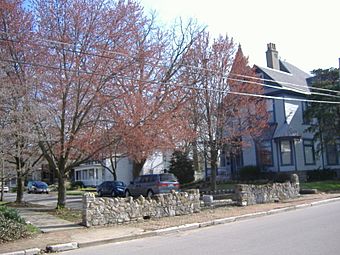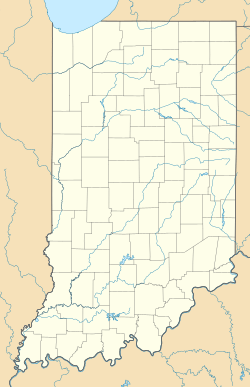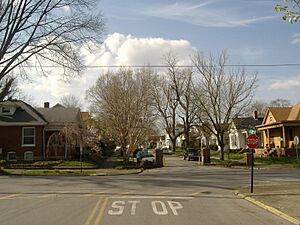Cedar Bough Place Historic District facts for kids
Quick facts for kids |
|
|
Cedar Bough Place Historic District
|
|

North Entrance
|
|
| Location | 800 blk. of Cedar Bough Pl., New Albany, Indiana |
|---|---|
| Area | 4.3 acres (1.7 ha) |
| Architectural style | Vernacular Victorian, Queen Anne, Bungalow, Airplane Bungalow and American Foursquare |
| NRHP reference No. | 08000188 |
| Added to NRHP | March 19, 2008 |
The Cedar Bough Place Historic District is a special neighborhood in New Albany, Indiana. It's known for its old, important buildings. You can find it near the Ohio River, across from Louisville, Kentucky. The district covers the 800-block of Cedar Bough Place, between Beeler and Ekin Avenues.
Contents
What Makes Cedar Bough Place Special?
This historic neighborhood has 25 main buildings, 7 smaller buildings (like garages), and a fence that are all part of its history. These buildings were mostly built between 1883 and 1920. Most of the houses were built between 1891 and 1905.
The buildings show different styles of architecture. Many are in the Vernacular Victorian and Queen Anne styles. You can also see Bungalow, Airplane Bungalow, and American Foursquare homes here.
The History of Cedar Bough Place
The land where Cedar Bough Place now stands was once part of a large 70-acre property. This property belonged to the Loughrey family in the early 1800s. The family later divided their land into many smaller plots. Lot #6, which was 5 acres, eventually became Cedar Bough Place.
In 1836, Margaret Loughrey sold parts of the land. She made a special rule that the streets and alleys were for the people who bought the lots. This meant that 90% of property owners had to agree before a street could become public. This rule made Cedar Bough Place a "private street."
Why a Private Street?
Private streets were a way for landowners to control their property. They could set their own rules for the neighborhood. This was important before cities had zoning laws. Zoning laws help control how land is used and developed.
Construction in the neighborhood began in 1890. This was 50 years after the land was first divided. Andros Huncilman started building homes on his 5-acre lot. Cedar Bough Place has always been a private street. The street itself is owned by the people who own the houses there.
Cedar Bough Place is one of the first private streets in the United States. For example, Lucas Place in St. Louis, Missouri was created 15 years later, in 1851. That private street no longer exists. The oldest private street still around in St. Louis, Missouri is Lafayette Square, which started in 1868. That's 32 years after Cedar Bough Place was made private.
No other city near New Albany, like Louisville, has private streets. Cedar Bough Place is the only private street in New Albany.
The Historic Fences
On the north side of the district, there is an old fence that adds to its historic look. It has a wrought iron gate connecting two original stone walls. This fence helps keep traffic from entering the private road. The fence on the south side was built in 1970. It replaced the original entrance and is wide enough for one car. This newer fence is not considered part of the district's original historic features.
Famous People Who Lived Here
Some notable people have lived in the Cedar Bough Place Historic District:
- Bernard Hock (a champion in table tennis)
- Ferdinand N. Kahler (an inventor and car maker)
- F. Shirley Wilcox (a leader in the Internal Revenue Service and Indiana State Treasurer)
Cedar Bough Place Today
In 1994, a study suggested that Cedar Bough Place could become a National Register site. In 2006, the Indiana Department of Natural Resources gave money to New Albany. This money helped prepare Cedar Bough Place and two other neighborhoods for this special recognition.
All three neighborhoods, including Cedar Bough Place, were officially added to the National Register of Historic Places on March 19, 2008. This means they are recognized as important historical places in the United States.




